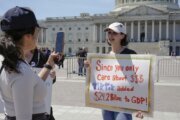WASHINGTON — Nearly a decade after the mortgage crisis that cost millions of Americans their homes, there’s another loan crisis looming.
It’s called the Parent Plus program — a government-run loan education program that has outstanding loans to 3 million Americans. It has allowed many young people to attend schools they couldn’t have afforded otherwise, but it has left thousands of parents in default, with delayed retirements and garnished Social Security checks and tax refunds — and these debts can’t be erased in bankruptcy.
That’s one reason that Joshua Mitchell, of The Wall Street Journal, told WTOP on Tuesday that “in some ways it’s worse” than the subprime mortgage crisis.
But that’s not the only way in which it’s worse than the mortgage crisis.
“There’s no cap on how much the parents can take out; they basically borrow whatever the schools charge,” he said. “And some of these parents had no income themselves, no savings, and yet they’re taking out tens of thousands of dollars and now they’re defaulting on these loans.”
Mitchell wrote that more than 11 percent of borrowers under the program had gone at least a year without having made a payment — more than the default rate on mortgages during that crisis.
Many of the borrowers are students from poor households who wanted to go to college during the recession, “and that’s a good thing,” Mitchell said, “because they wanted to learn new skills and improve their job prospects. But they also came from families that just didn’t have any other means, and private lenders wouldn’t give them money. So this was the only option.”
How to pay?
But as with the mortgage crisis, people were accepted with little to no examination of their ability to pay the loans back. Toby Merrill, of Harvard Law School’s Legal Services Center, told Mitchell in The Wall Street Journal story that “this credit is being extended on terms that specifically, willfully ignore their ability to repay. You can’t avoid that we’re targeting high-cost, high-dollar-amount loans to people who we know can’t afford to repay them.”
The Obama administration tried to tighten the eligibility requirements in 2011, Mitchell wrote, but backed off after colleges argued that they’d have to turn students away for inability to pay.
“A lot of schools rely on this program for their own money,” Mitchell told WTOP.
So now, Mitchell said, “A lot of [parents] are heading into retirement age … they’re having their Social Security checks garnished, because the government is allowed to do that. So a lot of them are going to have this problem for years and years.”
Mitchell wrote in The Journal that the number of Americans whose student debt led to reductions in their wages, tax refunds or Social Security benefits rose 71 percent between September 2010 and September 2015.
“I’ve talked with parents who are sometimes resentful of their kids,” Mitchell told WTOP. “They expected them to pay the bill, and now they can’t afford to pay it.”
The program is on the radar of the Trump administration and people on both sides of the aisle in Congress, Mitchell said, but they’re facing a problem.
“This actually scores as a profit on the budget, so it takes money to take away this program,” he said.
Until something happens on that end, Mitchell said, parents’ major option would be to go to the company that runs the program for the government and look to “refinance and lower their monthly bills.”





